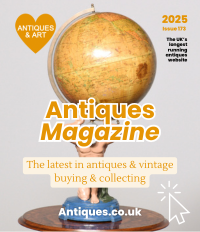featured item
antique berlin kpm plaque 'kunst bringt gunst signed knouller ca 1880

antiques available from other sellers in antique art > paintings
-
![Kalna Kaib?nu rija pie Vecpiebalgas]() £332.00
£332.00kalna kaib?nu rija pie vecpiebalgas Read more
SIA Antion -
![Before the rain View of the country road and the Ukrainian hut.]() £1886.00
£1886.00before the rain view of the country road and the ukrainia... Read more
SIA Antion -
![Port]() £384.00SIA Antion
£384.00SIA Antion -
![Jean Baptiste Said Claudot Claudot From Nancy (1733-1805) Paysage Animé]() £6281.23
£6281.23jean baptiste said claudot claudot from nancy (1733-1805)... Read more
Museumarte
- View other items in:
- antique art
- paintings
Still not found something similar? Why not save a search and get a notification in your inbox when an matching antique is added to our ever-growing database?
Enter your email address to be sent alerts when new items are added to the site that match your search criteria

This is an absolutely stunning and finely painted KPM Berlin Plaque after Paul Thumann's (1834-1908) 'Kunst Bringt Gunst'(meaning 'Art wins heart'), signed Knouller, circa 1880 in date.
This magnificent plaque is portrait in shape and depicts a candid young girl watching a graceful Greek artist while he is decorating a pottery vase. The young artisan is painting a black figure on the surface of the amphora while she is standing tall at the doorway and watching him.
Both figures dress in classical clothes and are set within a nostalgic environment reminiscent of antique ruins and of a paradisiac landscape. Indeed, a sweet and almost melancholy calm prevails. The original painting by the German artist, Thumann, just like many other of his romantic paintings, became very popular and was widely reproduced on porcelain plaques, plates and vases.
This truly splendid plaque is signed to the left bottom corner 'Knouller' and bears the impressed sceptre mark for KPM.
It is set in its original splendid gilt frame displaying foliate decorations to the border.
Add this splendid antique plaque to a very special wall in your home.
Condition:
The plaque and the gilded frame both in excellent condition, please see photos for confirmation.
Dimensions in cm:
Our reference: A1094a
TheRoyal Porcelain Factory in Berlin(German:Königliche Porzellan-Manufaktur Berlin, abbreviated asKPM), also known as theRoyal Porcelain Manufactory Berlinand whose products are generally called Berlin porcelain,was founded in 1763 by King Frederick II of Prussia(known as Frederick the Great). Its actual origins, however, lie in three private enterprises which, under crown patronage, were trying to establish the production of "white gold" (i.e. porcelain) inBerlinfrom the mid-18th century onwards.
In 1784, after a four-year development period, the king's desire for a soft and delicate shade of blue was fulfilled. The colour was known asBleu mourant("dying blue"), and it was used to decorateNeuzierat, Frederick's favourite dinner service. The colour was predominant in the king's private chambers at Sanssouci Palaceand in the blue chamber of the New Palace in Potsdam, as well as in other castles.
As owner of KPM, the king used the "white gold" as an effective means of diplomacy. Almost all of his diplomatic presents came from the manufactory, and they were to be found at the court of the tsars in Russia and on the tables of European aristocracy. Under Frederick the Great's successor, his nephew Frederick William II, the manufactory became a technologically leading enterprise. The new king obtained what he needed in the way of porcelain from KPM, but stopped paying cash. The amounts due were deducted from his share of the profits. The manufactory flourished. From 1787 onwards, the average annual net profit came to more than 40,000 thaler.
Antiques.co.uk Ref: NKG7WN7G8
- Width (cm):
- 18
- Height (cm):
- 24
- Depth (cm):
- 2.5
Here on antiques co uk we love antiques and specialise in selling antiques. Even though this item was for sale and is now sold or otherwise now unavailable we have many more items for sale including vintage antiques, silver, tables, watches, jewellery and much more for your interiors and home.
Search all the antiques currently for sale on www.antiques co uk. Or why not consider selling your antiques and making sales more easily with us!
regent antiques limited
Regent Antiques Limited has 986 antiques for sale.
click here to see them all












